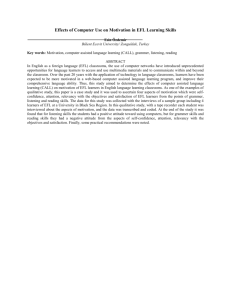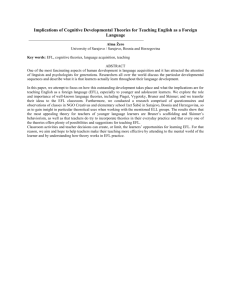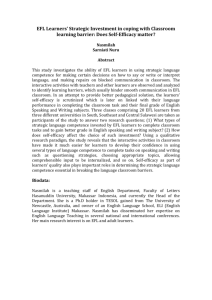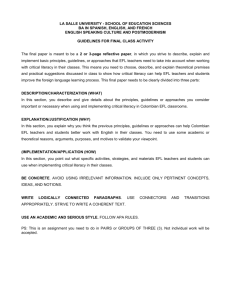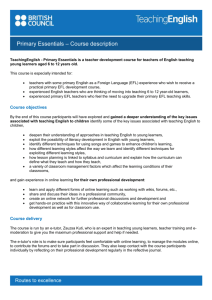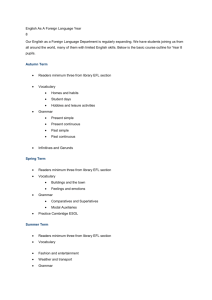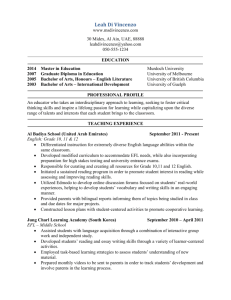this publication
advertisement
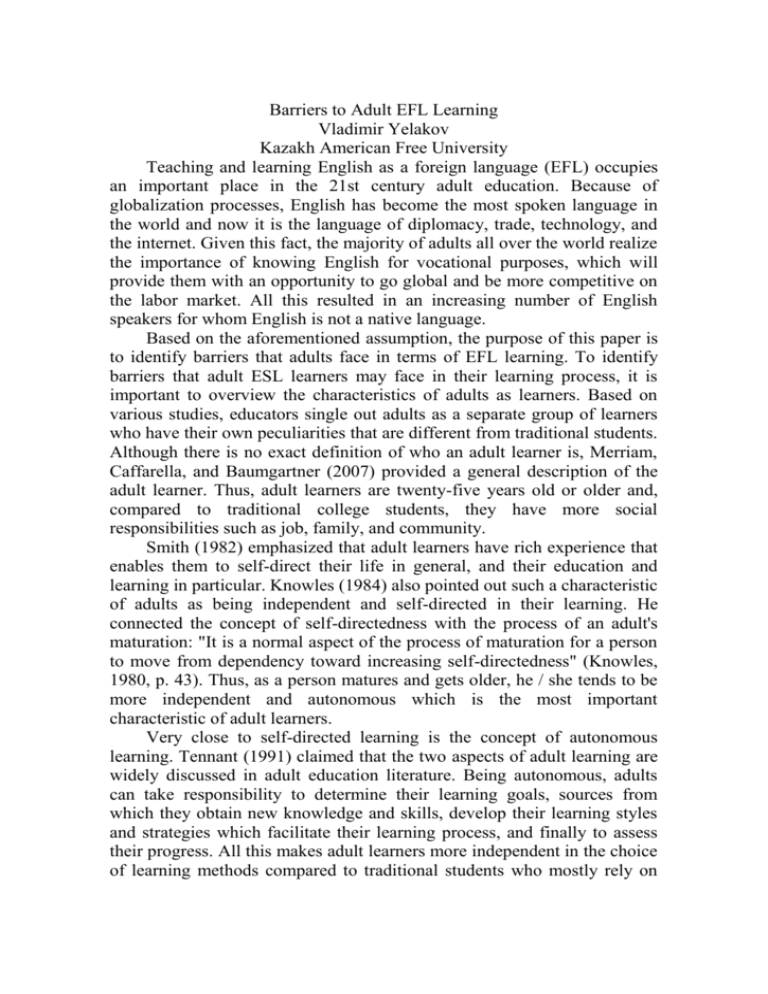
Barriers to Adult EFL Learning Vladimir Yelakov Kazakh American Free University Teaching and learning English as a foreign language (EFL) occupies an important place in the 21st century adult education. Because of globalization processes, English has become the most spoken language in the world and now it is the language of diplomacy, trade, technology, and the internet. Given this fact, the majority of adults all over the world realize the importance of knowing English for vocational purposes, which will provide them with an opportunity to go global and be more competitive on the labor market. All this resulted in an increasing number of English speakers for whom English is not a native language. Based on the aforementioned assumption, the purpose of this paper is to identify barriers that adults face in terms of EFL learning. To identify barriers that adult ESL learners may face in their learning process, it is important to overview the characteristics of adults as learners. Based on various studies, educators single out adults as a separate group of learners who have their own peculiarities that are different from traditional students. Although there is no exact definition of who an adult learner is, Merriam, Caffarella, and Baumgartner (2007) provided a general description of the adult learner. Thus, adult learners are twenty-five years old or older and, compared to traditional college students, they have more social responsibilities such as job, family, and community. Smith (1982) emphasized that adult learners have rich experience that enables them to self-direct their life in general, and their education and learning in particular. Knowles (1984) also pointed out such a characteristic of adults as being independent and self-directed in their learning. He connected the concept of self-directedness with the process of an adult's maturation: "It is a normal aspect of the process of maturation for a person to move from dependency toward increasing self-directedness" (Knowles, 1980, p. 43). Thus, as a person matures and gets older, he / she tends to be more independent and autonomous which is the most important characteristic of adult learners. Very close to self-directed learning is the concept of autonomous learning. Tennant (1991) claimed that the two aspects of adult learning are widely discussed in adult education literature. Being autonomous, adults can take responsibility to determine their learning goals, sources from which they obtain new knowledge and skills, develop their learning styles and strategies which facilitate their learning process, and finally to assess their progress. All this makes adult learners more independent in the choice of learning methods compared to traditional students who mostly rely on their teachers. As a result, adults tend to approach the learning process from a more critical perspective (Merriam, Caffarella, & Baumgartner, 2007). Making critical considerations of their learning, adults are able to determine challenges to the learning process as well as redirect it through self-monitoring and the instructor's facilitation. All these processes are influenced by and highly dependent on an adult's motivation. Motivation is indispensable in the learning process and it plays an important role in determining the success and effectiveness of learning. As is known, adults as learners are more mature than traditional college students, therefore they have stronger attitudes towards their learning objectives. Wlodkowski (1985) pointed out that certain attitudes can be a meaningful tool to determine an adult's particular learning behavior that enhances the effectiveness of the learning process through transformation into a particular goal that needs to be achieved. Generally, adults being more goal-oriented can identify the reasons why they need to gain new knowledge and skills and how they will foster their personal development in the future. This viewpoint brings up the intrinsic aspect of motivation, which occupies a leading position in adult learning. Merriam, Caffarella, and Baumgartner (2007) also indicated that adults are mainly intrinsically motivated that again can be tied to the ability to self-direct their learning. Thus, intrinsic motivation demonstrates a strong connection with selfdirected learning and reflects its nature. Following this idea, Elias and Merriam (2005) stated that "intrinsic motivation characterizes adult learners" (p. 128). Although self-directedness, intrinsic motivation, and rich life experiences are characteristic features of adult learners, there are some aspects of second language acquisition that can be applied only to those adults who engage in second language learning. Learning a foreign language is based on communication and oral skills practice. Moreover, adults need help when they learn language content. Thus, EFL learners usually hesitate to take all the responsibility for language learning as they are afraid of making mistakes, which may be perpetuated in the future language use without proper correction. In this case, the teacher should assume the role of mentor and facilitator to guide and monitor the process of second language acquisition. Accordingly, it is important for an EFL teacher to filter general assumptions about the nature of adult learners through cultural and linguistic backgrounds (Cunningham Florez & Burt, 2001). From the educational perspective, a barrier is defined as "any circumstance or condition which made a learning project difficult to continue, something that the learner had to surmount in order to persist in the learning initiative" (Guglielmino et al., 2005). As adult learning is characterized by the episodic nature (Tough, 1979), adults are more likely to encounter various barriers in the process of learning. In terms of adult EFL learning, barriers to learning English may be the result of the complex nature of second language acquisition. The specifics of EFL learning can underlie some learning barriers as well. As a whole, based on the literature analysis, barriers to EFL learning can be divided into three groups: instructional, cultural / language, and biological. The first group of barriers to EFL learning represents the instructional aspect. The organization of academic system represents one of the main barriers to adult EFL learning. According to adult learning theory, adults are experience-oriented in their learning process (Behrens, 1983). Adult learning does not begin with studying academic subjects. On the contrary, adults begin their learning based on situations drawn from their life experience. Thus, the controversy between adult learning and the academic system is that adults still have to adjust their learning process to academic requirements, which is commonly practiced in formal learning settings. The academic nature of EFL learning can be seen in educational standards, curricula, and learning resources that may not be totally based on learners' needs. The second group reflects cultural / language barriers that adult EFL learners encounter in the learning process. One of the common learning barriers from the cultural (or the first language) perspective is the adults' feeling that it is impossible to completely master a foreign language (Larsen-Freeman, 1991). Especially, this assumption is relevant for developing speaking and pronunciation skills, although it may apply to other language competencies as well. The effectiveness of second language acquisition can be enhanced if there is more focus on the standard layer of English. In this case, learners concentrate on standardized patterns of language that are understood and spoken by all the native speakers. However, it should be noted that the majority of adult EFL learners realize that complete mastery of a foreign language is an ideal goal, which does not fit in with their practical needs. Another important factor is a learner's age. It represents a biological barrier and affects the process of EFL learning at all its levels. Merriam, Caffarella, and Baumgartner (2007) indicated that a person's age affects the process of learning in general. It takes older adults more time to process new information and memorize it. This is especially relevant for EFL learning because it requires much time, energy, and good memory. TESOL (2003) also supported this idea stating that having a variety of learners of different ages in the classroom "create[s] additional instructional challenges" (p. 9) as the difference in learners' ability to acquire new language competencies becomes apparent in this case. TESOL (2003) presented some other barriers encountered by adults in EFL learning. As the process of second language acquisition is timeconsuming and requires much diligence, adult learners are unable to combine EFL learning and social responsibilities imposed on them. For example, adults have job responsibilities and in most cases, they have to work long hours. Thus, it is difficult for them to change working hours schedule and adjust them to their EFL classes. Also, adult learners have to take family responsibilities, especially if they have children or take care of elder members of their families. Adults face barriers concerning transportation issues, for example, if EFL classes are not held in their community or in the neighborhood. In such situations, adult learners have to find available transportation to afford EFL learning. To sum up, adult EFL learning occupies an important place in the field of education. It is evident that the number of non-native speakers of English is increasing due to globalization processes. In this vein, there are more providers of EFL programs nowadays. Although adult learners are different, their learning process can be characterized by self-directedness, intrinsic motivation, and richer life experience. However, as for EFL learning, it cannot be completely based on self-directedness because communication in a second language plays a key role in EFL learning. EFL learning emphasizes the importance of building new knowledge on the learners' previous experience, providing feedback, and applying different learning strategies. Also, it should be taken into account that the process of second language acquisition is complex and dynamic, it is closely connected with the concept of culture and is affected by the learner's first language. Based on EFL learning principles, the barriers to EFL learning can be divided into three groups: instructional, cultural (language), and biological. References 1. Merriam, S. B., Caffarella, R. S., & Baumgartner, L. M. (2007). Learning in adulthood: A comprehensive guide (3rd ed.). San Francisco, CA: Jossey-Bass 2. Smith, R. M. (1982). Learning how to learn: Applied theory for adults. New York, NY: Cambridge, The Adult Education Company 3. Knowles, M. S., & Associates. (1984). Andragogy in action: Applying modern principles of adult learning. San Francisco, CA: Jossey-Bass 4. Knowles, M. S. (1980). The modern practice of adult education: From pedagogy to andragogy. Chicago, IL: Follett Publishing Company 5. Tennant, M. (1991). The psychology of adult teaching and learning. In J. M. Peters, P. Jarvis, & Associates (Eds.), Adult education: Evolution and achievements in a developing field of study (pp. 191 – 216). San Francisco, CA: Jossey-Bass 6. Wlodkowski, R. J. (1985). Enhancing adult motivation to learn. San Francisco, CA: Jossey-Bass 7. Elias, J.L., & Merriam, S.B. (2005). Philosophical foundations of adult education (3rd ed.). Malabar, FL: Krieger Publishing Company 8. Cunningham Florez, M., & Burt, M. (2001). Beginning to work with adult English language learners: Some considerations. Center for Adult English Language Acquisition. Retrieved from: http://www.evenstartnetwork.net/LiteracyDevelopment/website/reso urces/6.pdf 9. Guglielmino, L. M., Asper, D., Findley, B., Lunceford, C., McVey, R. S., Payne, S., Penney, G., & Phares, L. (2005). Common barriers, interrupters, and restarters in the learning projects of self-directed adult learners. International Journal of Self-Directed Learning, 2 (1), 71 – 93 10.Tough, A. (1979). The adult's learning projects (2nd ed.). Toronto, Canada: Ontario Institute for Studies in Education 11.Behrens, S. (1983). From the classroom to the workplace: Teaching ESL to adults. Washington, DC: Center for Applied Linguistics 12.Larsen-Freeman, D. (1991). Second language acquisition research: Staking out the territory. TESOL Quarterly, 25 (2), 315 – 350 13.Teachers of English to Speakers of Other Languages (TESOL). (2003). Standards for adult education ESL programs. Arlington, VA: Kirby Lithographic Company, Inc.

